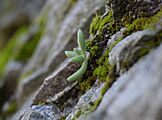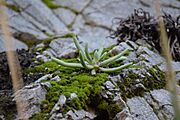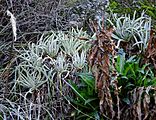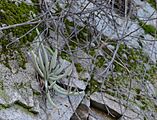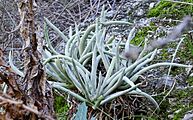Dudleya densiflora facts for kids
Quick facts for kids Dudleya densiflora |
|
|---|---|
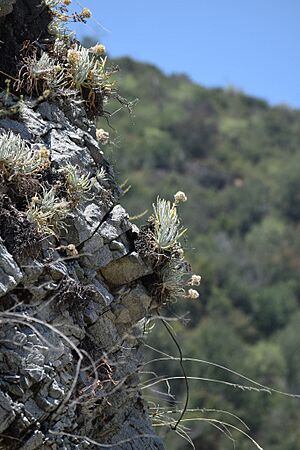 |
|
| Plants growing on a cliff, with their flower stalks in bloom. | |
| Conservation status | |
| Scientific classification | |
| Genus: |
Dudleya
|
| Species: |
densiflora
|
| Synonyms | |
|
|
Dudleya densiflora is a very rare type of succulent plant known by the common names San Gabriel Mountains liveforever or San Gabriel Mountains dudleya. This special plant is only found in the San Gabriel Mountains in Los Angeles County, California.
Scientists believe there are only about 1,700 of these plants left in the wild. They live in just three to five locations within the mountain range. The plant makes its home in the cracks of granite cliffs in three canyons. Its survival is threatened by human activities like rock quarrying and people hiking off the main trails.
Contents
What does it look like?
The San Gabriel Mountains liveforever grows in clumps. It has long, powdery leaves that are shaped like pencils. From spring until June, it grows a branching stalk with a rounded cluster of white or pink flowers.
This plant looks similar to its relatives, Dudleya edulis and Dudleya viscida. However, you can tell it apart by its powdery white leaves and its rounded flower cluster, which isn't flat on top.
Plant Structure
This Dudleya grows in clumps, with many groups of leaves called rosettes. These rosettes sit on top of thick, branching stems known as a caudex. A single clump can grow to be 30 cm (about 12 inches) across and have 20 to 40 leaves.
The leaves are covered in a fine, white, waxy powder. This powder, called epicuticular wax, helps protect the plant. Underneath the powder, the leaves are green. Each leaf is long and thin, measuring 6 to 15 cm long (2.4 to 5.9 inches) and 6 to 12 mm wide (0.24 to 0.47 inches).
Flowers and Stalks
The main flower stalk, or peduncle, stands 10 to 30 cm (4 to 12 inches) tall. The stalk has 5 to 15 small, pointed leaves called bracts growing on it.
The top of the stalk branches out several times. Each of these smaller branches holds 2 to 8 flowers. The flowers hang from tiny stems called pedicels. The petals are white or pink and form a flower that is about 12 to 20 mm (0.5 to 0.8 inches) wide.
Where does it live?
This plant is found only in a very small area in southern California. It grows at the southern edge of the San Gabriel Mountains, near the opening of the San Gabriel Canyon and Fish Canyon.
Its habitat is on steep rock faces, cliffs, and the walls of canyons, usually made of granite.
Why is it endangered?
The San Gabriel Mountains liveforever is in danger because its home is being disturbed by people. A large granite quarry near Azusa is a major threat. The permit for this quarry was given in 1956, before many laws to protect the environment were created.
The quarry also blocks the entrance to Fish Canyon, which used to be a public trail. In Fish Canyon, this rare plant grows alongside another unique local plant, the Dudleya cymosa subsp. crebrifolia.
Gallery
See also
- Dudleya multicaulis
- Dudleya cymosa subsp. crebrifolia
- Dudleya viscida



